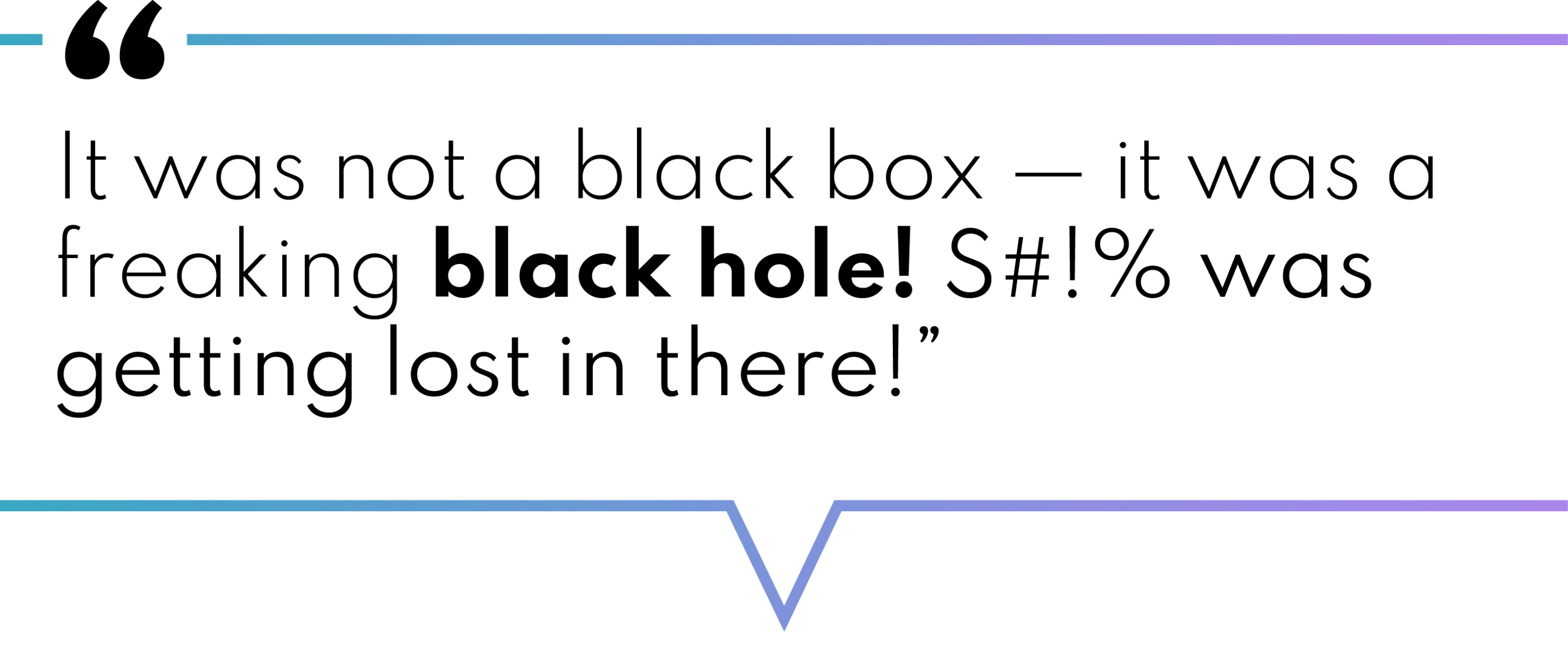
How a Wholesale Distributor Escaped a ‘Black Hole’

– Cavallo® co-founder Pete Eardly,
describing his distribution operation before he created Cavallo SalesPad®
This tale of a black hole isn’t science fiction; it’s the story of a real distributor who blasted off from an antiquated system of 12 physical clipboards on a wall to create a command-and-control center on a smartphone.
The results? Out of this world.
Pete first shared his story with me when I was considering coming aboard Cavallo as CEO. I wanted to explore the actual daily lives of the company’s customers.
When I evaluate companies I want to work with, I start with two basic questions: “Does this company create tremendous value in ways that are deeply important to the end customer?” And, “Does it scale?” (As a data nerd, I consider “tremendous value” to be statistically significant growth by tenfold or more. If I don’t feel connected to real value creation, I’m not interested.)
Pete Eardley wasn’t just the guy who’d ultimately hire me. He was also Cavallo Customer #1, someone who had grown his own wholesale distribution business into a resilient, hyper-competitive, and wildly profitable mid-market success.
That meant he was the first person whose story I needed to hear if I wanted to understand a day in the life of a Cavallo user. Pete’s tale would be validated time and again by customers I spoke with. Despite its rewards, managing a small to mid-size distribution business was a daily exercise in firefighting.
The journey to success
During that first conversation, Pete told me how he did his best to “control the controllables” by:
- Hiring good employees,
- Training them to a standard, and
- Trusting that they performed to spec in managing every line item of every order, every time — from quoting a customer to the collection of cash.
In other words, he’d assembled a great crew to propel his business forward. The challenge was to give them the controls they needed to spot a black hole in time to steer clear of it.
Pete’s own view from the command deck was less than stellar. Over days and weeks, his metrics were limited to “orders in” and “shipments out.” (He later acknowledged he wasn’t sure he even knew those figures with confidence on a daily basis.) While he was pleased with the general growth trend, Pete believed he could do a lot better.
Like many businesses, Pete would only get the full picture of his profitability and other financial measures after the accounting period — several days into the next month. That lag made it difficult to get ahead of issues, maximize profitability, and drive continuous improvement. (Never mind the impact on Pete’s fishing, hunting, and golf plans!)
Out of the black hole
Like other top-performing business leaders, Pete was so averse to waste and inefficiency, leaving them unresolved was never an option. He could sense an unproductive process a mile away. He also knew his ERP system alone was not designed to deliver the visibility, control, and insights he needed.
It wasn’t that his ERP was deficient. It simply wasn’t designed to meet his outsize vision of the future — one in which he’d know with certainty that every order would land in the “perfect order” slot. Most ERP systems are generalist tools. They support common enterprise-wide data and business processes, and they deliver required financial accounting and reporting capabilities. They’re not designed to meet industry verticals’ specific and stringent requirements.
Escaping information black holes profitably and at scale requires technology. Pete’s precise vision, combined with a lack of patience for a lengthy software selection process, led him to build his own solution…now almost two decades ago.
The results were world-beating. In his last two fiscal years before selling his distribution company to private equity, return on assets exceeded 90%; revenue per head was two times the industry benchmark; and days sales outstanding (DSO) was cut in half.
One business rule alone enabled Pete to capture more than $300,000 in incremental profit per year. Essentially, this one pricing rule prevented “leaking” cost-of-goods-sold (COGS) improvements through pricing decisions made by the sales team. Therefore, every cent of COGS improvement that he wanted to preserve dropped straight to the bottom line.
The rest is history
After seeing the results within his own shop, Pete would ultimately market his in-house software solution as commercial software known as Cavallo’s Order Intelligence (formerly SalesPad).
Cavallo helped other companies as much as it had helped Pete’s. With the right technology in place, leaders can set and forget their entire order management process, confident that every order is handled precisely the way they want. They can advance from chaos to control.
Trading firefighting for control lets business leaders make significantly more money. It also helps them sleep better at night without wondering what could go wrong — or if they’ll even realize it when it happens.
Control over his operations reduced Pete’s typical work week to 20 or 25 hours. His wife would ask him at the start of his weekdays, “Are you fishing, hunting, playing golf, or working today?” Via his smartphone, Pete retained control over the dials in his business whether he was on the ninth hole or a fishing boat on the Atlantic Ocean.
Spotting black holes in your operation
You can achieve similar results at a cost that can deliver substantial ROI — but first, you need to know where in your operation to look. With that end in mind, start with an honest assessment of where you are today.
We’ve talked to many business owners and decision-makers who believed their day-to-day chaos was just part of wholesale distribution. It’s eye-opening and refreshing to realize that there is a better way.
The first step to navigating your enterprise’s own black holes: an honest and thorough assessment of your current situation.
- Do I have complete command over all of my processes? Analyze each process and grade it as a Strength, Moderate Gap, or Significant Gap. Using Lean 6 Sigma waste types can be a helpful perspective: Defects, Overproduction, Waiting, Non-Utilized Talent, Transportation, Inventory, Motion, and Excess Processing.
- Can your problem or pain point stand up to the “5 Whys”? This technique was developed by Toyota Industries in the 1930’s and used by many firms since. It helps get through the subjective layer of a problem and get down to the root cause.
- Do I have data (KPIs) to prove how my processes are performing? Review your reporting to determine if it’s giving you an accurate readout of your performance. It’s critical to have full control of the factors driving KPIs so you know if you’re “winning” or “losing.”
What’s next?
If you are in absolute command of your dials and have already escaped your own version of the black hole, congratulations! Read my next installment about operational variables to learn more about optimizing your workflow.
For everyone else, here’s your opportunity to become the benchmark instead of chasing it.
Decision-makers have several technology options to consider. These include building their own custom software and finding commercial applications that deliver the configurability, highly flexible business rules, and automation to achieve complete command of their quote-to-cash operations.
At a minimum, your selection criteria should include consideration of:
- Fit to requirements (business and technical)
- Time to value
- Return on investment
- Long-term flexibility
- Risk
Work with a trusted technology partner to assess your options. If you want guidance on choosing the right tech partner or would like to discuss your journey with one of our experts, we’re happy to help in any way that we can.
While an entire paper could be dedicated to the art and science of software selection, it’s not my purpose here. Instead, my prime directive is to declare that there is a way out of the black hole.
You can simultaneously tame the chaos in the order, gain a competitive advantage, improve your financial performance, and gain more free time to live long and prosper.
Want to see more? Take a look at the next two blogs in this series:

